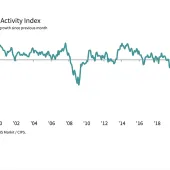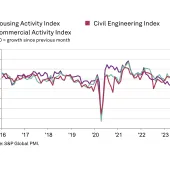CPA forecasts recession in construction for 2023
Construction Products Association forecasts 4.7% fall in output in 2023 before slow recovery in 2024
THE construction industry is expected to endure a recession this year after two strong years for the industry. According to the Construction Products Association’s Winter Forecasts, construction output is expected to fall by 4.7% in 2023 before recovering slowly in 2024 with growth of just 0.6%.
Private housing new build, the largest construction sector, and private housing repair, maintenance, and improvement, the third-largest sector, are forecast to be the worst affected sectors this year. Falls in activity in these areas are expected to be partially offset by continued growth in infrastructure, the second-largest sector, which is already at historic high levels of activity. Even here, however, concerns are growing over the impacts of double-digit construction cost inflation. Given financial constraints for government, the CPA says the value of activity expected previously is likely to remain the same but not the volume.
Private housing is forecast to be the sector most affected by the downturn and fortunes for the sector over the next 12–18 months are likely to go one of two ways. The main forecast anticipates a soft landing for the housing market, which involves a sharp decline in demand during the first quarter of 2023 before a recovery in demand this Spring.
Nevertheless, private housing output in 2023 is forecast to experience an 11.0% fall as house builders focus on completing existing developments rather than starting new sites. This fall is primarily due to rising mortgage rates, falling real wages and poor consumer confidence. Plus, there is now a less-friendly government policy environment for house builders, given the end of Help to Buy, the Residential Property Developer Tax and the Building Safety Levy.
The largest impact of the decline in demand is likely to be on property transactions, which are anticipated to fall by around 20% in 2023, whilst house prices are anticipated to decline by 8–10%. After two consecutive years of double-digit growth, house prices will return to levels seen around a year ago. However, if demand does not recover from Spring as mortgage rates continue to fall, private housing could fall even further, as is outlined in the CPA’s Lower Scenario.
Private housing repair, maintenance, and improvement output was driven to historic high levels in 2021 due to increased working from home and a ‘race for space’. With falling real wages, poor consumer confidence and double-digit construction cost inflation, many homeowners were quick to start delaying smaller, discretionary improvements work and output has been falling since March 2022.
Larger improvements work, however, continued last year as households had pencilled in the finance for it at the start of 2022. Given further expected falls in real wages and increases in mortgage payments for many households this year, a further decline in private housing repair, maintenance, and improvement output of 9.0% is forecast in 2023. This will focus on a fall in larger improvements activity, before slow growth of 1.0% in 2024 as activity recovers in line with the wider UK economy.
Infrastructure continues to go from strength to strength, reaching historic high levels in 2022 as it benefitted from multi-billion-pound projects such as HS2, the Thames Tideway Tunnel and Hinkley Point C, as well as long-term frameworks activity in sub-sectors such as rail, roads and energy.
Going forward, further growth in infrastructure output is expected but it is likely to be slower than in previous years due to cost inflation and financial constraints. The Chancellor stated clearly in the Autumn Statement that capital expenditure would be maintained in cash terms. In the near-term, this is likely to mean that current central government projects go over budget given double-digit construction cost inflation.
Also, there will be hesitancy from the public sector signing up to new projects due to uncertainty over costs spiralling further. In addition, financially constrained councils are likely to cut spending on new projects to cover the rising costs of essential repairs and maintenance. In the medium-term, projects towards the end of the Government’s Spending Review are expected to be pushed back into the next review period due to budgetary constraints. After 4.9% growth in 2022, infrastructure output is forecast to rise by 2.4% in 2023 and 2.5% in 2024.
CPA economics director Noble Francis said: ‘The construction industry has enjoyed a buoyant two years since the first national lockdown largely shuttered the industry back in Spring 2020 and activity remains high for the moment. Overall, however, construction output is forecast to fall by 4.7% this year. It is worth keeping in mind the broader context that this is not 2008 and the decline is nowhere near the fall in output that occurred in the last recession. Looking back 15 years ago, construction output fell by 15.3% over two years during the global financial crisis.
‘Private housing and private housing repair, maintenance, and improvement, two of the three largest construction sectors, are highly dependent on the wider UK economy, interest rates, real wages and consumer confidence. So, as the UK economy falls into recession, interest rates rise, real wages fall and consumer confidence remains poor, construction output will fall sharply in these sectors. These falls will be partially offset by continued growth in infrastructure but that means that it is more important than ever that government maintains its commitments to meeting its own targets by investing in levelling up, its infrastructure pipeline and transitioning to Net Zero.’







